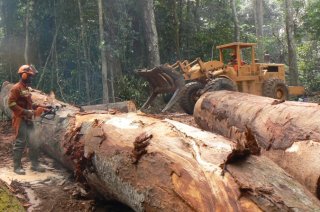
Project
TIMTRACE
An estimated 50-90 percent of the traded volume of tropical timber is illegally sourced. To implement new European legislation intended to eliminate this illegal trade, independent tools will be needed to verify the legal status of timber. We therefore propose to develop a fast, accurate and cost-effective commercial forensic tool for tracing the claimed origin of tropical timber.
In March 2013, the European Union (EU) implemented the EU timber regulation (EUTR), which prohibits any illegally sourced timber from entering the EU market. The EUTR requires the timber industry to ascertain that all tropical timber traded in the EU originates from a legal source. It is implemented through a ‘due diligence system’ in which the legal status of imported tropical timber is based on certificates and trade documents. Such a ‘paper control system’ is however subject to fraud, so independent methods are increasingly needed to check the claimed origin of tropical timber.
We are developing a forensic timber tracing service, Timtrace, which independently verifies the geographical origin of tropical timber. Specifically, we use:
(1) stable isotopes (e.g. δ13C, δ18O, δ15N), trace elements and rare earth elements in wood that can be matched with regional reference data (PhD: Laura Boeschoten) and
(2) DNA analysis, using microsatellite markers and SNPs to distinguish trees from different populations (PhD: Barbara Rocha Venancio Meyer-Sand).
We apply multiple methods as this allow methodological comparisons and tracing of a large number of tropical timbers. Over the past years, we have assembled a database with stable isotope values of >13,000 entries for 50 timbers from 25 countries. Using this database we are able to correlate large-scale spatial variation in δ18O in wood with isotopic signature of rain water (Figure), with potential for isotopic tracing at large spatial scales. At smaller scale, we have successfully applied microsatellites of the African timber Tali to trace the origin of timber samples to concessions in Cameroon (Vlam et al. 2018).
Timtrace will fulfil the increasing demand for independent verification of the claimed origin of tropical timber. Interested parties and potential customers of our tracing service include: (1) customs and inspection authorities; (2) timber-processing industry; (3) NGOs and (4) organisations that certify sustainable forest management, which conduct forensic checks to underpin the credibility of their certification.
We coordinate our efforts with the Global Timber Tracking Network, in the recently launched Phase II of the project.
Wood samples needed
We need wood samples of African timbers (specifically Azobé and Tali) and Indonesian timbers (specifically Dark red Meranti). If you can provide these wood samples, please contact us directly.
In the media
- April 30,2023 - Dutch Radio 1 Vingerafdruk hout
- March 25, 2021 - Dutch Radio 1 "Hoe ontdek je fout hout"
- November 2019 - NWO tijdschrift Onderzoek: Fout hout opsporen
- June 2018 - WageningenWorld (magazine Wageningen University & Research): "Tracking down illegal timber"
- March 8, 2018 - Mongabay (conservation news site): "Where does your timber come from? Genetic analysis may soon tell you"
- March 6, 2018 - KIJK (Dutch site for science and technology):" Kan deze DNA-techniek illegale houtkap tegengaan?"
- March 5, 2018 -Dutch news paper: "Nieuw wapen in strijd tegen fout hout: dna-test stelt afkomst met precisie vast." (de Volkskrant, Wetenschap)
- March 1, 2018 - FEM site, news: "Genetic properties help identify illegally traded tropical hardwood"
- November 14, 2017 - online EU Research Magazin: "Tree rings used to counter smugglers’ rings". Interview with Pieter Zuidema. (Horizon, EU Research & Innovation Magazin)
- March 11, 2015 - Dutch news paper: Streepjescode herkent fout hout. (Trouw, De verdieping pp.12-13)